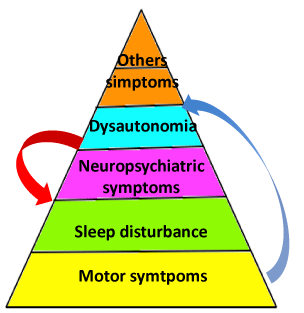Standard Algorithm and Tailor-Made Treatment in Parkinson Disease: How to Find a Balance??
Maria Chiara Malaguti*
Department of Neurological Sciences, Neurology Unit, Santa Chiara Regional Hospital
*Address for Correspondence: Maria Chiara Malaguti, Department of Neurological Sciences. Neurology Unit; Santa Chiara Regional Hospital, Largo Medaglie door no.1; 38100 Trento- Italy, Tel: +390461903281/393382036337; Fax: +390461902439; E-mail: [email protected]
Submitted: 10 August 2017; Approved: 16 August 2017; Published: 18 August 2017
Citation this article: Malaguti MC. Standard Algorithm and Tailor-Made Treatment in Parkinson Disease: How to Find a Balance? Scientific Journal of Neurology & Neurosurgery. 2017;3(2): 035-036.
Copyright: © 2017 Malaguti MC. This is an open access article distributed under the Creative Commons Attribution License, which permits unrestricted use, distribution, and reproduction in any medium, provided the original work is properly cited
Keywords: Treatment Parkinson Disease
Download Fulltext PDF
Parkinson Disease (PD) is a neurodegenerative disorder that goes toward continuous changes and transformation. It starts with some symptoms but ends with many others that usually become more troublesome than the initial ones. We have a large collection of disposable treatment options to face the disease in its evolution.
The scientific literature is rich in many algorithms and flow charts showing how to proceed in the management of the disease, for example when the patient is more or less young at the onset or when news symptoms occur [1]. At the same time, many papers showing these flow charts emphasize the importance of a patient-centered approach where the fundamental principle governing patient care is a customized treatment tailored to the specific needs of each patient [1, 2]. The problem is how to find a balance between a flow chart where the patient steps in a well-defined track following a precise way and a tailor-made therapy, which seems to require a more talented skill to “sew a treatment dress” around the patient. The literature lacks to mention how to tailor this dress, and it seems to depend only on the neurologist’ own ability.
When the patient comes into the outpatient clinics, he comes with its life story, his caregiver, his job and his functional demand, which differ from one patient to another.
To respond to patients’ personal request and to follow at the same time literature guidelines, I propose building a hierarchy of needs for any single patient, where the patient identifies a severity level to all motor and non motor symptoms in his personal life.
I suggest building a pyramid of needs, like Maslow did in the sixties for human needs [3], for any single parkinsonian person [Figure 1]. The pyramid of needs represents the prior needs at the bottom and helps the patients and the neurologist to focus on the most important goals to achieve.
Over time, needs in this hierarchy are moving up and down in the pyramid according to Hoen and Yar (H&Y) stages of the disease, but also according to patients stage of personal life (eg. working activity rather than retirement). At the beginning of the disease prior needs are usually motor symptoms and affective disorders like depression, but, going on, motor and non-motor fluctuation occurs, some non-motor symptoms worsen and the hierarchy of needs changes. Over time, priority changes again, with falls, freezing of gait, cognitive decline or psychosis sited at the bottom of the pyramid. Often in the latest and terminal stage of PD, the prior needs are those of the caregiver rather than patient’s ones. Moreover it could happen that patients are not aware of their needs, such the cases of Dopamine Dysregulation Syndrome and Impulse control disorders; in these cases the task of the neurologist is to help the patient to focus on the right problem. Patients who share the same H&Y stage can complain with different priorities: for example someone does not bear the burden of motor fluctuation, while others can find more difficult to cope with disautonomic symptoms or sleep disturbance.
Building a pyramid with the hierarchy of needs is not another scale to add to the many scales already used in scientific literature (UPDRS, PDQ39 etc.). Within “participatory medicine” [4], the pyramid of needs is a tool to include the patient perspective in the therapeutical project; it is an instrument the neurologist should use face to face to patient, to focus on the most important goals to achieve in any stage combining disease aspects and personal life needs and to make the best treatment choice within the large disposable drugs armamentarium.
- Jankovic J, Poewe W. Therapies in Parkinson's disease. Curr Opin Neurol. 2012; 25: 433-47. https://goo.gl/pSUFzP
- Nisenzon AN, Robinson ME, Bowers D, Banou E, Malaty I, Okun MS. Measurement of patient-centered outcomes in Parkinson’s disease: what do patients really want from their treatment? Parkinsonism Relat Disord. 2011; 17: 89-94. https://goo.gl/D6EVhJ
- Maslow, A. Toward a Psychology of Being. Van Nostrand, New York, 1962. https://goo.gl/mCB1hB
- van der Eijk M, Nijhuis FA, Faber MJ, Bloem BR. Moving from physician-centered care towards patient-centered care for Parkinson's disease patients. Parkinsonism Relat Disord. 2013; 19: 923-7. https://goo.gl/VQ4Bhk


Sign up for Article Alerts